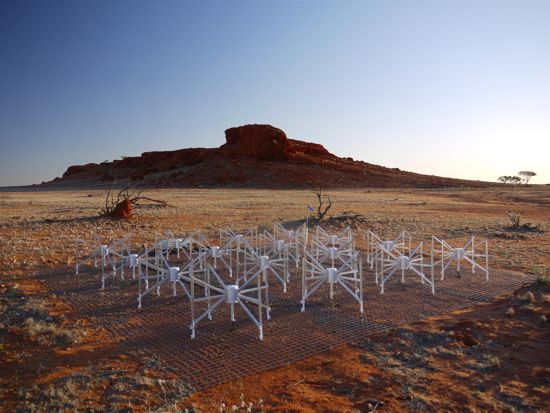The first modern Search for ExtraTerrestrial Intelligence (SETI) experiment at low radio frequencies is underway, as researchers utilise the capabilities of the Murchison Widefield Array (MWA) to search the skies for the tell-tale signs of an advanced civilisation.
SETI experiments using radio telescopes first started in 1960 when Cornell University astronomer Frank Drake used the Green Bank telescope in West Virginia to examine two nearby stars. Since then a number of programmes, such as the Million-channel ExtraTerrestrial Assay (META) programme and SERENDIP (Search for Extraterrestrial Radio Emissions from Nearby Developed Intelligent Populations) plus offshoots of this experiment, have continued to search the skies ever since.
The search for life beyond our own neighbourhood has focused on scanning the radio portion of the electromagnetic spectrum, as the radio band on Earth is the corner-stone of communications technologies. It is therefore reasonable to assume that extraterrestrial civilisations may have also followed a similar technological path and used this frequency range for the same purposes.
Looking for radio waves produced by an advanced civilisation is not an easy task however, as the Universe is full of objects that emit their own radio waves over many different frequencies. It is therefore the task of teams such as this one from Italy and Australia to separate a manufactured signal from an astronomical one.
To do this, the team, whose lead author on the research paper is S.J. Tingay from the International Centre for Radio Astronomy Research (ICRAR) and the Istituto di Radio Astronomia in Italy, used the MWA, one of the most powerful low-frequency radio telescopes located in a remote, radio-quiet region of Western Australia, which is also one of three telescopes designated as a precursor for the Square Kilometre Array (SKA), to examine spectral line data generated from 115 minutes of observation time with the telescope.
Within the field of view that the data was gathered from – approximately 400 square degrees – the team had to extract signals from 45 exoplanets in 38 planetary systems to ensure they were not confused with anything else. And, while the field of view that the team observed was large, the frequency range they covered was not particularly big. Nonetheless, this SETI pilot experiment has proved successful and taking into consideration the MWA’s operational frequency range, and its wide field of view, the team state that the Murchison Widefield Array provides a unique capability for future SETI projects.
Indeed, the team further state, that to perform a SETI experiment to the same depth as achieved in this experiment, but over the full MWA frequency range of 80 - 300 MHz, and over the full accessible sky from Western Australia, would require approximately one month of observing time – a goal that is entirely feasible for the near future. And, if that is possible, then so too should be a deeper look into the Universe, only that would require about a year to complete.
This pilot experiment is the start of bigger things to come, as one of the key science programs for the SKA, when it is operational, is themed the “cradle of life.” This will involve, amongst other things, systematic, volume-limited searches of exoplanet systems for signals from technologically advanced civilisations. The search therefore will continue, and it may not be too long before we find out whether we really are alone in the Galaxy or not.
For more information on this latest experiment, please click here http://arxiv.org/pdf/1607.08818.pdf











